Gertrude Jekyll
| Gertrude Jekyll | |
|---|---|
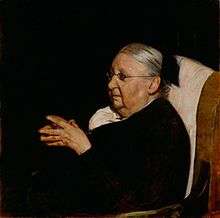 Portrait of Jekyll by William Nicholson, painted October 1920; commissioned by Edwin Lutyens, donated to the Tate Gallery in 1921 | |
| Born | 29 November 1843 |
| Died | 8 December 1932 (aged 89) |
| Nationality | English |
| Occupation | Horticulturist, garden designer, writer and artist |
.jpg)
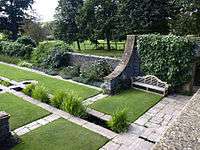
Gertrude Jekyll (/ˈdʒiːkəl/ JEE-kəl; 29 November 1843—8 December 1932) was an influential British horticulturist, garden designer, artist[1] and writer. She created over 400 gardens in the United Kingdom, Europe and the United States, and wrote over 1,000 articles[1] for magazines such as Country Life and William Robinson's The Garden.[2] Jekyll has been described as "a premier influence in garden design" by English and American gardening enthusiasts.[1]
Early life
Jekyll was born at 2 Grafton Street, Mayfair, London, the fifth of the seven children of Captain Edward Joseph Hill Jekyll, an officer in the Grenadier Guards, and his wife Julia Hammersley. Her younger brother, Walter Jekyll (an Anglican priest; sometime Minor Canon of Worcester Cathedral and Chaplain of Malta), was a friend of Robert Louis Stevenson, who borrowed the family name for his famous novella Dr Jekyll and Mr Hyde. In 1848 her family left London and moved to Bramley House, Surrey, where she spent her formative years.
Themes
Jekyll was one half of one of the most influential and historical partnerships of the Arts and Crafts movement, thanks to her association with the English architect, Edwin Lutyens, for whose projects she created numerous landscapes, and who designed her home Munstead Wood, near Godalming in Surrey.[3] (In 1900, Lutyens and Jekyll's brother Herbert designed the British Pavilion for the Paris Exposition.)
Jekyll is remembered for her outstanding designs and subtle, painterly approach to the arrangement of the gardens she created, particularly her "hardy flower borders".[4] Her work is known for its radiant colour and the brush-like strokes of her plantings; it is suggested by some that the Impressionistic-style schemes may have been due to Jekyll's deteriorating eyesight, which largely put an end to her career as a painter and watercolourist. In works like Colour Schemes for the Flower Garden (reprinted 1988) she put her imprint on modern uses of "warm" and "cool" flower colours in gardens.
Jekyll was one of the first of her profession to take into account the colour, texture, and experience of gardens as the prominent authorities in her designs, and she was a lifelong fan of plants of all genres. Her theory of how to design with colour was influenced by painter J.M.W. Turner and by impressionism, and by the theoretical colour wheel. Later in life, Jekyll collected and contributed a vast array of plants solely for the purpose of preservation to numerous institutions across Britain. This pure passion for gardening was started at South Kensington School of Art,[5] where she fell in love with the creative art of planting, and even more specifically, gardening. At the time of her death, she had designed over 400 gardens in Britain, Europe and a few in North America. Jekyll was also known for her prolific writing. She penned over fifteen books, ranging from Wood and Garden and her most famous book Colour in the Flower Garden, to memoirs of her youth. Jekyll did not want to limit her influence to teaching the practice of gardening, but to take it a step further to the quiet study of gardening and the plants themselves.[6] Her concern that plants should be displayed to best effect even when cut for the house, led her to design her own range of glass flower vases.[7]
Jekyll later returned to her childhood home in the village of Bramley, Surrey to design a garden in Snowdenham Lane called Millmead. She was also interested in traditional cottage furnishings and rural crafts, and concerned that they were disappearing. Her book Old West Surrey (1904) records many aspects of 19th-century country life, with over 300 photographs taken by Jekyll.
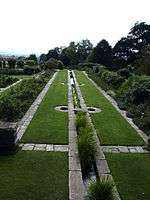 Hestercombe Gardens
Hestercombe Gardens Jekyll's restored long border at Upton Grey Manor House, Hampshire
Jekyll's restored long border at Upton Grey Manor House, Hampshire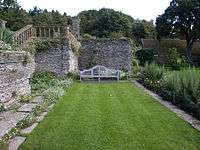 Hestercombe Gardens, the Lutyens designed bench
Hestercombe Gardens, the Lutyens designed bench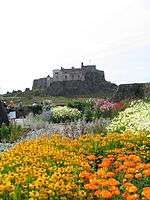
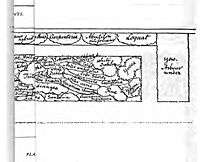 Jekyll's plan for a flowerbed
Jekyll's plan for a flowerbed
Gardens
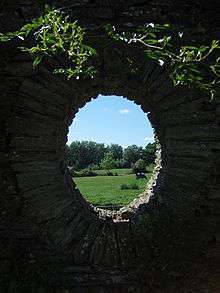
From 1881, when she laid out the gardens for Munstead House, built for her mother by John James Stevenson, Jekyll provided designs or planned planting for some four hundred gardens. More than half were directly commissioned, but many were created in collaboration with architects such as Lutyens and Robert Lorimer.[8] Most of her gardens are lost. A small number have been restored, including her own garden at Munstead Wood, the gardens of Hestercombe House, and the garden at the Manor House in Upton Grey that she designed for the magazine editor Charles Holme.[8][9]
Awards
Jekyll was awarded the Victoria Medal of Honour of the Royal Horticultural Society in 1897 and the Veitch Memorial Medal of the society in 1929. Also in 1929, she was given the George Robert White Medal of Honor of the Massachusetts Horticultural Society.[8][10]
Death
Jekyll is buried in the churchyard of Busbridge Church, formerly known as St John the Baptist, Busbridge, Godalming, next to her brother and sister-in-law, Herbert Jekyll and his wife, the artist, writer and philanthropist Agnes Jekyll. The monument was designed by Edwin Lutyens.[11]
 Gertrude Jekyll's gravestone
Gertrude Jekyll's gravestone Jekyll family memorial in Busbridge Church churchyard
Jekyll family memorial in Busbridge Church churchyard
Bibliography
- Jekyll, G. Wood and Garden (Longmans, Green and Co., 1899).
- Jekyll, G. Home and garden (Longmans, Green and Co., 1900).
- Jekyll, G. & Mawley, E. Roses for English Gardens (London: Country Life, 1902).
- Jekyll, G.. Wall and water gardens (London: Country Life, 1902).
- Jekyll, G. Lilies for English gardens (London: Country Life, 1903).
- Jekyll, G. & Elgood, G. S (illustrator), Some English gardens (Longmans, Green & Co., 1904)
- Jekyll, G. Old West Surrey (Longmans, Green, and Co., 1904).
- Jekyll, G. Colour in the flower garden (London: Country Life, 1908).
- Jekyll, G. Annuals & biennials (London: Country Life, 1916)
- Jekyll, G. Children and gardens ( London: Country Life, 1908).
- Jekyll, G. & Weaver, Lawrence. Gardens for small country houses (London: Country Life, 1914).
- Jekyll, G. Colour schemes for the flower garden (London: Country Life, 1919).
See also
- The Bois des Moutiers (she designed some gardens of the Bois des Moutiers)
- Garden design
- Ralph Hancock (landscape gardener)
- Hascombe Court (designed by Jekyll)
- History of gardening
- Planting design
- Garden of Eden, Venice, the garden of Jekyll's sister Caroline
References
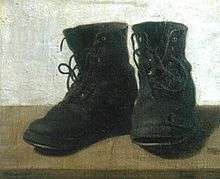
- 1 2 3 Van Matre, Lynn (26 February 1989). "In Bloom Again: Gertrude Jekyll`s Cult Status Is In Full Flower". Chicago Tribune. Retrieved 3 June 2012.
- ↑ Bisgrove, Richard. The Gardens of Gertrude Jekyll.London: Frances Lincoln, 2006.
- ↑ Tankard, Judith B. and Martin A. Wood. Gertrude Jekyll at Munstead Wood. Bramley Books, 1998.
- ↑ The Gardens of Gertrude Jekyll by Richard Bisgrove 1992
- ↑ "About Gertrude Jekyll". Archived from the original on 27 October 2007. Retrieved 19 December 2007.
- ↑ Wood, Martin. The Unknown Gertrude Jekyll.London: Frances Lincoln, 2006.
- ↑ Swengley, Nicole (24 November 2010). "Gertrude Jekyll vase designs set to sparkle again". The Telegraph. Retrieved 3 June 2012.
- 1 2 3 Michael Tooley (2004). Jekyll, Gertrude (1843–1932). Oxford Dictionary of National Biography. Oxford University Press. doi:10.1093/ref:odnb/37597
- ↑ Betty Massingham (2006 [1975]). Gertrude Jekyll: An Illustrated Life of Gertrude Jekyll, 1843–1932. Princes Risborough: Shire Press. p. 44.
- ↑ Desmond, Steven (23 January 2010). "Great British Garden-Makers: Gertrude Jekyll". Country Life Magazine. Retrieved 3 June 2012.
- ↑ "Busbridge War Memorial". Historic England. Retrieved 13 December 2015.
- ↑ IPNI. Jekyll.
Further reading
- Bisgrove, Richard (2000). The Gardens of Gertrude Jekyll. Berkeley: University of California Press. ISBN 0-520-22620-8.
- Desmond, Steven (23 January 2010). "Great British Garden-Makers: Gertrude Jekyll". Country Life Magazine. Retrieved 3 June 2012.
- Eberle, Iwona: Eve with a Spade: Women, Gardens, and Literature in the Nineteenth Century. Munich: Grin, 2011. ISBN 9783640843558
- Sinclair, Jill (16 June 2006). "Review: The Unknown Gertrude Jekyll, 'Queen of the mixed border'". The Guardian. Retrieved 3 June 2012.
External links
| Wikiquote has quotations related to: Gertrude Jekyll |
| Wikimedia Commons has media related to Gertrude Jekyll. |
- The Gertrude Jekyll Estate
- Restored Jekyll garden in Sandwich, Kent
- Restored Jekyll garden at Upton Grey
- Short biography of Jekyll from Emily Compost
- Online text of Gertrude Jekyll's Colour schemes for the flower garden (1921)
- Restored Jekyll garden at Durmast House, Burley, Hampshire, UK
- Jekyll garden in Woodbury CT, USA
- Gertrude Jekyll's garden designs @ Ward's Book of Days
- The Times Obituary
- A Gertrude Jekyll and Edwin Lutyens garden in france (1898
- Detailed family history
- Connection between Jekyll, Eden, Baring, Hammersley and Poulett-Thomson families
- "Archival material relating to Gertrude Jekyll". UK National Archives.
- Works by Gertrude Jekyll at Project Gutenberg
- Works by or about Gertrude Jekyll at Internet Archive
- Works by Gertrude Jekyll at LibriVox (public domain audiobooks)
